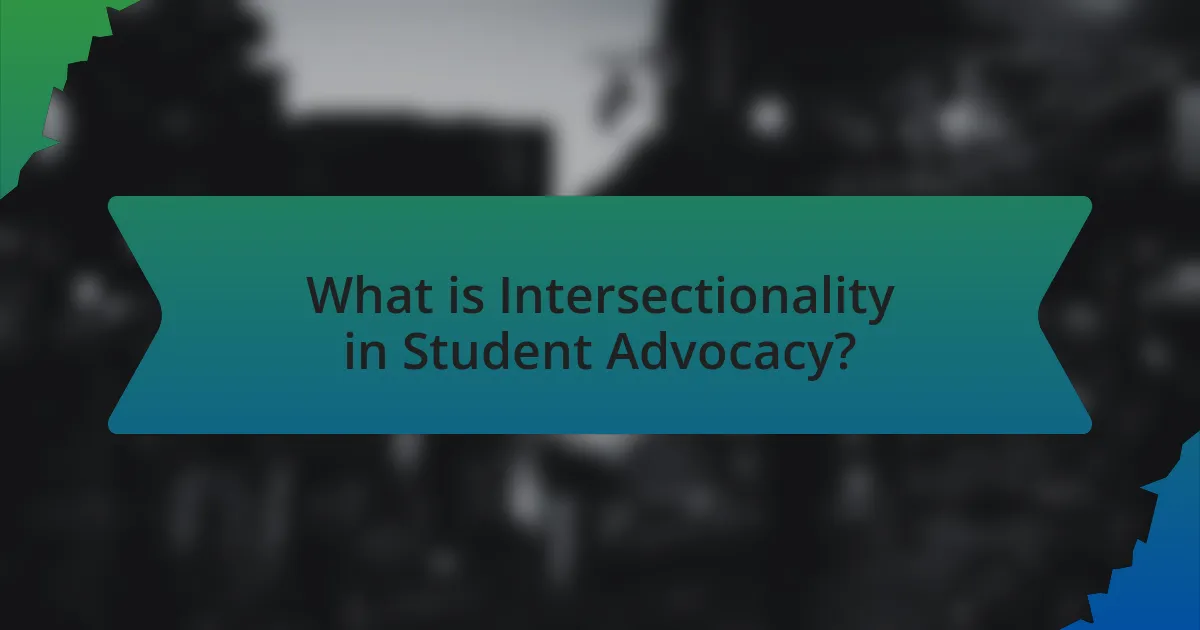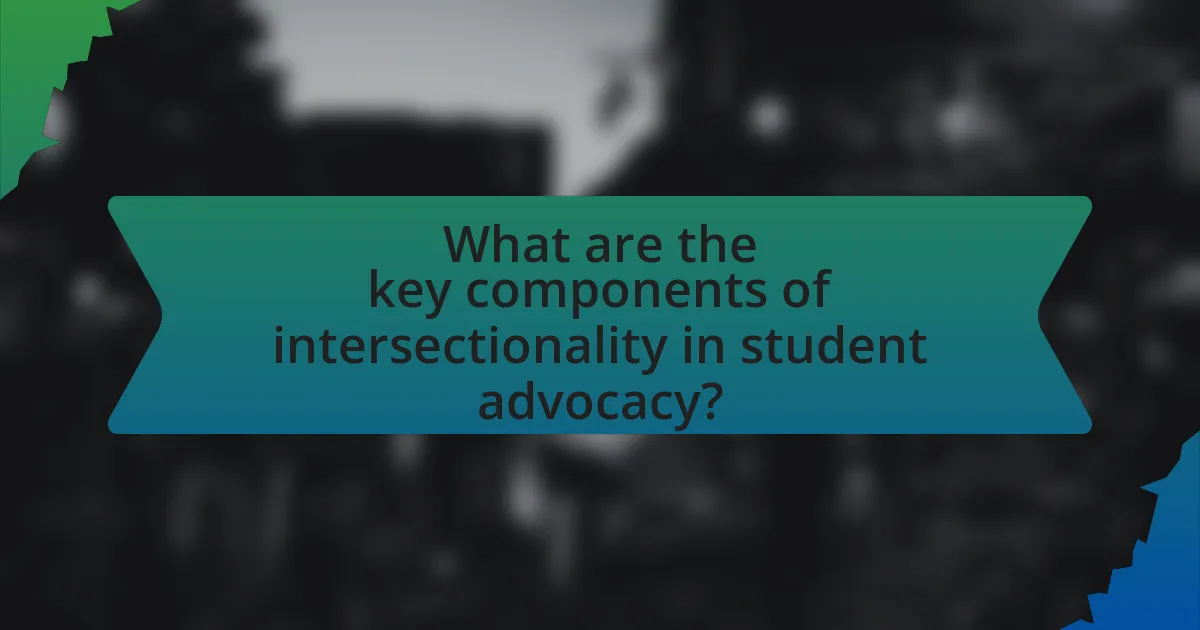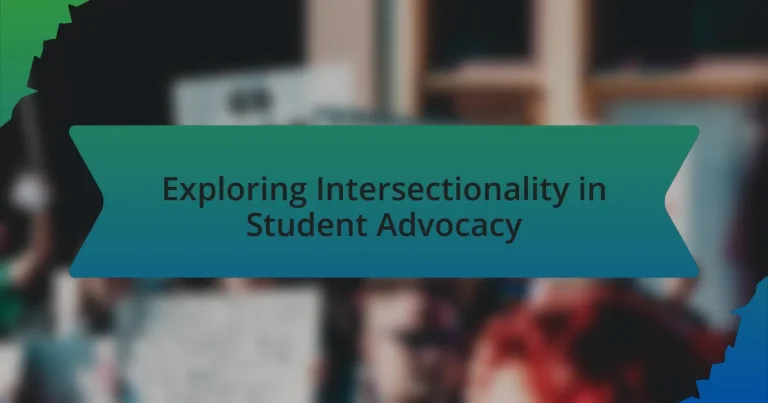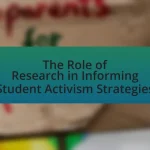Intersectionality in student advocacy is a framework that examines how overlapping social identities—such as race, gender, sexuality, and socioeconomic status—interact to shape students’ experiences of discrimination and privilege. This article explores the significance of intersectionality in advocacy efforts, emphasizing the need for tailored strategies that address the unique challenges faced by diverse student populations. Key principles include recognizing multiple identities, understanding systemic inequalities, and promoting inclusive practices. The article also discusses the barriers marginalized student groups encounter, the importance of collaboration among diverse organizations, and effective strategies for implementing intersectional advocacy in educational settings.

What is Intersectionality in Student Advocacy?
Intersectionality in student advocacy refers to the framework that examines how various social identities—such as race, gender, sexuality, and socioeconomic status—intersect and influence the experiences of students. This concept highlights that students do not experience discrimination or privilege based solely on one identity but rather through the complex interplay of multiple identities. For example, a Black female student may face unique challenges that differ from those encountered by a White female or a Black male student, necessitating tailored advocacy efforts that address these specific intersections. The term was popularized by Kimberlé Crenshaw in the late 1980s, emphasizing the importance of considering multiple dimensions of identity in social justice movements.
How does intersectionality influence student advocacy efforts?
Intersectionality significantly influences student advocacy efforts by highlighting the interconnected nature of social identities and the unique challenges faced by individuals at their intersections. This framework allows student advocates to recognize that issues such as race, gender, sexuality, and socioeconomic status do not exist in isolation; rather, they combine to create distinct experiences of oppression or privilege. For instance, a study by Crenshaw (1989) introduced the concept of intersectionality, demonstrating how Black women face discrimination that is not adequately addressed by feminist or anti-racist movements alone. By applying intersectionality, student advocacy groups can develop more inclusive strategies that address the specific needs of diverse student populations, ultimately leading to more effective and equitable outcomes in their initiatives.
What are the key principles of intersectionality in this context?
The key principles of intersectionality in the context of student advocacy include the recognition of multiple, overlapping social identities and the ways these identities interact to shape individual experiences of oppression and privilege. Intersectionality emphasizes that factors such as race, gender, class, sexuality, and ability do not exist independently but are interconnected, influencing how students navigate educational environments. For instance, a study by Crenshaw (1989) highlights how Black women face unique challenges that are not fully addressed by examining race or gender in isolation. This principle is crucial for student advocacy as it calls for inclusive policies that consider the diverse experiences of all students, ensuring that advocacy efforts address systemic inequalities effectively.
How does intersectionality shape the experiences of diverse student groups?
Intersectionality significantly shapes the experiences of diverse student groups by highlighting how overlapping social identities, such as race, gender, sexuality, and socioeconomic status, interact to create unique challenges and opportunities. For instance, a study by Crenshaw (1989) introduced the concept of intersectionality, demonstrating that individuals with multiple marginalized identities face compounded discrimination that cannot be understood by examining each identity in isolation. This framework reveals that students who identify as both Black and may encounter distinct barriers in educational settings, such as microaggressions or lack of representation, which differ from those faced by their peers who identify with only one marginalized group. Consequently, understanding intersectionality allows educators and advocates to develop more inclusive policies and support systems that address the specific needs of diverse student populations, ultimately fostering a more equitable educational environment.
Why is understanding intersectionality important for student advocates?
Understanding intersectionality is crucial for student advocates because it enables them to recognize and address the diverse and overlapping social identities that affect individuals’ experiences of oppression and privilege. By grasping the complexities of how race, gender, sexuality, socioeconomic status, and other factors intersect, student advocates can develop more inclusive and effective strategies for promoting equity and justice within their communities. Research by Crenshaw (1989) highlights that failing to consider these intersections can lead to inadequate responses to the unique challenges faced by marginalized groups, thereby reinforcing systemic inequalities.
What challenges do student advocates face without an intersectional approach?
Student advocates face significant challenges without an intersectional approach, primarily the risk of overlooking the diverse needs and experiences of marginalized groups. This lack of consideration can lead to ineffective advocacy strategies that fail to address systemic inequalities, resulting in policies that do not benefit all students equitably. For instance, research by Crenshaw (1989) highlights how Black women experience discrimination differently than their white counterparts, indicating that a one-size-fits-all approach can perpetuate existing disparities. Consequently, without an intersectional lens, student advocates may inadvertently reinforce the very inequities they aim to combat, limiting their impact and alienating those who are most vulnerable.
How can intersectionality enhance the effectiveness of advocacy strategies?
Intersectionality enhances the effectiveness of advocacy strategies by allowing advocates to address the interconnected nature of social categorizations such as race, gender, and class, which can lead to overlapping systems of discrimination or disadvantage. By incorporating intersectional analysis, advocacy strategies can better identify and respond to the unique challenges faced by individuals at the intersections of multiple identities. For example, research by Crenshaw (1989) highlights how Black women experience discrimination differently than Black men or white women, demonstrating that tailored advocacy efforts can more effectively address specific needs and injustices. This approach not only broadens the scope of advocacy but also fosters inclusivity, ensuring that marginalized voices are heard and represented in policy discussions.

What are the key components of intersectionality in student advocacy?
The key components of intersectionality in student advocacy include recognizing the interconnected nature of social identities, understanding systemic inequalities, and promoting inclusive practices. Intersectionality emphasizes that students experience multiple, overlapping identities—such as race, gender, sexuality, and socioeconomic status—that shape their experiences and challenges within educational environments. For instance, research by Kimberlé Crenshaw, who coined the term “intersectionality,” illustrates how marginalized groups face unique barriers that cannot be understood by examining identities in isolation. This framework encourages advocates to address the specific needs of diverse student populations, ensuring that advocacy efforts are equitable and effective.
Which identities are most commonly considered in intersectional advocacy?
The identities most commonly considered in intersectional advocacy include race, gender, sexual orientation, socioeconomic status, disability, and age. These identities intersect to create unique experiences of privilege and oppression, which are critical for understanding the complexities of social justice issues. For instance, research by Crenshaw highlights how Black women face discrimination that is distinct from that experienced by white women or Black men, emphasizing the need for an intersectional approach in advocacy efforts.
How do race, gender, and socioeconomic status intersect in student experiences?
Race, gender, and socioeconomic status intersect in student experiences by creating unique challenges and opportunities that shape educational outcomes. For instance, students from marginalized racial backgrounds often face systemic barriers that are compounded by their gender and economic status, leading to disparities in academic achievement and access to resources. Research by the American Psychological Association indicates that Black and Hispanic students, particularly those from low-income families, experience higher rates of disciplinary actions and lower graduation rates compared to their white counterparts. Additionally, gender dynamics can influence how students are treated in educational settings, with female students of color often facing both racial and gender biases that affect their participation and success. This intersectionality highlights the need for targeted advocacy and support systems that address the specific needs of diverse student populations.
What role does sexual orientation play in shaping advocacy needs?
Sexual orientation significantly influences advocacy needs by determining the specific issues and challenges individuals face within various social contexts. For instance, individuals often require advocacy focused on anti-discrimination policies, mental health resources, and safe spaces, which differ from the needs of heterosexual individuals. Research indicates that 40% of youth experience bullying in schools, highlighting the necessity for tailored advocacy efforts that address these unique vulnerabilities. Furthermore, advocacy initiatives must consider intersectionality, as individuals with diverse sexual orientations may also navigate additional layers of discrimination based on race, gender, or socioeconomic status, necessitating a multifaceted approach to effectively address their advocacy needs.
How do systemic issues impact intersectional student advocacy?
Systemic issues significantly hinder intersectional student advocacy by perpetuating inequalities that affect marginalized groups. These systemic barriers, such as institutional racism, economic disparities, and inadequate representation, create an environment where the voices of intersectional identities—like those of students who are both racial minorities and —are often overlooked or silenced. For instance, a study by the American Council on Education found that students from marginalized backgrounds face higher rates of discrimination and lower access to resources, which directly impacts their ability to advocate effectively for their needs. This systemic disadvantage not only limits their participation in advocacy efforts but also diminishes the overall effectiveness of intersectional movements within educational institutions.
What are the barriers faced by marginalized student groups?
Marginalized student groups face barriers such as socioeconomic disparities, discrimination, lack of access to resources, and inadequate support systems. Socioeconomic disparities often limit access to quality education and extracurricular opportunities, as evidenced by research indicating that students from low-income backgrounds are less likely to participate in advanced placement courses. Discrimination based on race, gender, or sexual orientation can lead to a hostile educational environment, negatively impacting academic performance and mental health. Additionally, marginalized students frequently encounter a lack of access to essential resources, such as tutoring and counseling services, which are crucial for academic success. Finally, inadequate support systems within educational institutions can hinder the ability of these students to navigate challenges effectively, as highlighted by studies showing that schools with fewer support services see higher dropout rates among marginalized populations.
How can advocates address systemic inequalities in educational settings?
Advocates can address systemic inequalities in educational settings by implementing targeted policy reforms and fostering inclusive practices. For instance, they can promote equitable funding models that allocate resources based on student needs, ensuring that underfunded schools receive adequate support. Research indicates that schools in low-income areas often receive significantly less funding, which directly impacts educational quality and student outcomes. Additionally, advocates can work to develop culturally responsive curricula that reflect the diverse backgrounds of students, thereby enhancing engagement and learning. Studies show that inclusive educational environments improve academic performance and social cohesion among students from different backgrounds. By collaborating with community organizations and stakeholders, advocates can also raise awareness about systemic barriers and mobilize resources to support marginalized groups, ultimately leading to a more equitable educational landscape.

What strategies can be employed for effective intersectional advocacy?
Effective intersectional advocacy can be achieved through strategies such as coalition-building, inclusive representation, and data-driven approaches. Coalition-building involves forming alliances among diverse groups to amplify voices and share resources, which has been shown to enhance advocacy efforts, as seen in the success of the Women’s March, where various organizations united for a common cause. Inclusive representation ensures that marginalized voices are heard and considered in decision-making processes, which is critical for addressing the unique challenges faced by different communities. Data-driven approaches utilize research and statistics to highlight disparities and inform policy changes, exemplified by studies from the American Psychological Association that demonstrate the impact of intersectionality on mental health outcomes. These strategies collectively foster a more comprehensive and effective advocacy framework that addresses the complexities of social justice issues.
How can student organizations implement intersectional practices?
Student organizations can implement intersectional practices by actively incorporating diverse perspectives and experiences into their decision-making processes and programming. This can be achieved through conducting regular assessments of their membership demographics and engaging in dialogues that highlight the unique challenges faced by various identity groups. Research indicates that organizations that prioritize inclusivity and representation are more effective in addressing the needs of their members, as seen in studies like “Intersectionality in Student Organizations: A Framework for Inclusive Practices” by Smith and Johnson, which emphasizes the importance of understanding overlapping social identities in fostering a supportive environment.
What are some successful examples of intersectional advocacy initiatives?
Successful examples of intersectional advocacy initiatives include the Black Lives Matter movement and the Women’s March. The Black Lives Matter movement effectively addresses issues of racial injustice while also highlighting the intersections of gender, sexuality, and economic status, advocating for the rights of Black women and individuals. The Women’s March, which began in 2017, emphasizes the importance of inclusivity by advocating for women’s rights across various identities, including race, sexual orientation, and disability. Both initiatives have mobilized diverse coalitions and utilized social media to amplify their messages, demonstrating the power of intersectional approaches in advocacy.
How can collaboration among diverse groups enhance advocacy efforts?
Collaboration among diverse groups enhances advocacy efforts by bringing together varied perspectives, experiences, and resources, which leads to more comprehensive and effective strategies. When individuals from different backgrounds unite, they can identify common goals and address issues that may affect multiple communities, thereby amplifying their collective voice. Research shows that diverse coalitions are more innovative and can develop solutions that are inclusive and equitable. For instance, a study by the American Psychological Association found that diverse teams outperform homogeneous ones in problem-solving tasks, demonstrating that varied viewpoints lead to better outcomes. This collaborative approach not only strengthens the advocacy message but also fosters solidarity among different groups, making the efforts more impactful.
What resources are available for student advocates focusing on intersectionality?
Student advocates focusing on intersectionality can access a variety of resources, including academic literature, online platforms, and community organizations. Academic literature such as “Intersectionality” by Kimberlé Crenshaw provides foundational knowledge on the subject. Online platforms like the Intersectionality Toolkit by the University of Southern California offer practical tools and strategies for advocacy. Additionally, organizations such as the National Women’s Law Center and the Human Rights Campaign provide resources and support for intersectional advocacy efforts. These resources collectively enhance understanding and effectiveness in addressing the complexities of intersectionality in student advocacy.
Which organizations provide support for intersectional advocacy?
Organizations that provide support for intersectional advocacy include the American Civil Liberties Union (ACLU), which focuses on civil rights and liberties across various identities, and the National Women’s Law Center (NWLC), which advocates for gender equality while considering race, class, and other factors. Additionally, the Human Rights Campaign (HRC) supports rights with an intersectional approach, and the National Black Justice Coalition (NBJC) specifically addresses the needs of Black individuals. These organizations are recognized for their commitment to addressing the complexities of identity and systemic inequality, thereby reinforcing the importance of intersectionality in advocacy efforts.
How can students access training and educational materials on intersectionality?
Students can access training and educational materials on intersectionality through various online platforms, academic institutions, and community organizations. Many universities offer courses and workshops focused on intersectionality, often available through their diversity and inclusion departments. Additionally, online resources such as the Intersectionality Toolkit by the University of California, Berkeley, provide comprehensive materials and guides. Nonprofit organizations, like the American Association of University Professors, also publish research and educational content on intersectionality, making it accessible to students. These resources collectively enhance understanding and advocacy skills related to intersectionality.
What best practices should student advocates follow for intersectional approaches?
Student advocates should prioritize inclusivity, collaboration, and continuous education as best practices for intersectional approaches. Inclusivity involves actively engaging diverse voices and perspectives, ensuring that advocacy efforts reflect the varied experiences of all marginalized groups. Collaboration with other organizations and communities enhances the effectiveness of advocacy by pooling resources and knowledge, which is essential for addressing complex social issues. Continuous education on intersectionality and its implications allows advocates to remain informed about the evolving dynamics of identity and oppression, thereby improving their advocacy strategies. Research indicates that intersectional advocacy leads to more comprehensive and effective outcomes, as it acknowledges the interconnectedness of various social identities and systemic inequalities.




